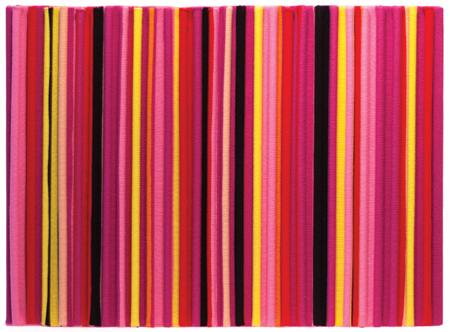
December 7, 2012 through January 5, 2013
Sam Jaffe's studio lies towards the rear of an ivy-covered warehouse. It is bright and welcoming inside with one, massive window, a parked motorcycle, two seamstress mannequins, a microwave, a knitting machine and an abundance of yarn. Jaffe makes brightly colored textile works that exist somewhere between sculpture, fashion, and painting. This December, she will install her second-ever solo show, "One by One," at Chicago's 65 Grand Gallery.
A jagged 10-foot sculpture hangs from the ceiling. It turns slightly from an invisible draft, revealing many, multi-angled facets. The invisible foam core structure is covered in striped blue, pink and yellow ochre fabric that fits close like a sock; every edge is traced by a continuous blue tinsel seam. It's reminiscent of a knitted lightning bolt, or a shard of crystal from a hipster comic. It captures something of Jaffe's past: In 2001 she enrolled as a freshman in Rhode Island School of Design's painting department--right at the tail-end of Providence's Fort Thunder-era, when hipster print-makers, noise musicians and creative ruffians defined the city's aesthetic. "I certainly feel influenced by that work," Jaffe says.
Whereas Fort Thunder prided itself in low-fi, disposable aesthetic, Jaffe's work is inextricably tied to the labor of production. "I come from a long line of female textile workers," Jaffe explains. "The maternal side of my family all worked for mills in Boston. My grandfather was also a loom-fixer as a child." Jaffe can spend as much as twelve hours at a time, knitting row after row of knots but her agenda is anything but functional. "I am really interested in refuse and the cast-off material that society throws away: old costumes, bits of fabric, and thread." She incorporates a variety of strategies to weave those elements together, adding plush stuffed animal limbs, or swatches of thrift store sweaters, that she then combines with sections constructed on a '70s-era home knitting machine or knitted by hand. "When you bring all those things together you create this weird situation where you're not really sure what's handmade, and what's industrially produced." The result is a pastiche of material, each with its own associated and material history.
"My show at 65 Grand is going to be a bit of a departure. The work is going to be pretty geometric." Moving away from the opulent beadwork that has so far been a regular part of Jaffe's oeuvre, she is constructing a series of minimalist tapestries. "I'm still using crazy neon colors, but the work as a whole is pared down." She means to further exacerbate the tension between a handmade and industrial aesthetic, except in this case Jaffe addresses two distinct, canonized schools of thought. Fiber is a warm, organic and often personal medium, with longstanding ties to feminism. Minimalism is its perfect foil as a rarefied manifestation of formal interests, historically dominated by men. One insists on the human hand whereas the other tried to remove it entirely. It's a good juxtaposition to play with,†she says. "In fiber, you're always thinking of detail, something that's handmade. When you think of something minimal it's cold and manufactured." Jaffe plays with that same tension in the yarn she uses, preferring a synthetic material. "Acrylic yarn is the cheapest yarn you can buy. It's the lowest quality and it's really rough and uncomfortable to touch." Because it's plastic, it comes in a zinging range of colors. "I think the color gives it that sickly synthetic look to it, so it kind of has this gross/beautiful thing that I really enjoy."
The industry that initially supported Jaffe's ancestors has all but vanished in this country; what sites they might have worked--old mills in Providence and Boston--remain abandoned, co-opted by squatting art kids, or redeveloped into condominiums. "That's why it's interesting as an American to explore some of the possibilities in fiber production, because it's something that we just don't experience day-to-day."
This article was written for and published in art ltd. magazine ![]()
